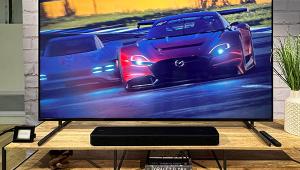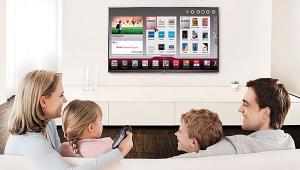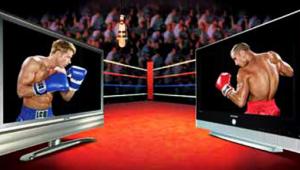Projector & Screen Basics Page 2
There’s more to choosing a screen than size and room lighting. Space won’t allow for a detailed discussion of all the factors here, but screen manufacturers’ Websites have plenty of information on the various options and features. Some of the main considerations are:
Gain
Screens are passive devices, so they don’t have gain per se. However, they do have different reflective characteristics. A screen with a gain of 1.0 is equally reflective in all directions; you’ll lose very little image brightness as you move off center. Higher-gain screens tend to focus more of their reflected light toward the middle. This increases the brightness for viewers seated there but reduces it for those on the sides. But high gain can result in hot-spotting and other non-uniform characteristics, and it’s best reserved for a very large screen where image brightness is all important.

A screen that has a gain of about 1.3, which offers about 30 percent more brightness in a center seat than a 1.0-gain screen, is a safe and widely accepted option. It will provide reasonable brightness for the average home theater projector. Lower gains may offer superior performance in subtle ways, but they require careful projector selection if you want a pleasing image brightness, particularly in larger screen sizes.
To Perf or Not to Perf
Some screens are acoustically transparent—more or less. They use a woven material or a material with scores of tiny microperforations. You can position your center-channel speaker (or all of your front speakers) behind them. While it’s certainly an advantage for dialogue to come directly from the center of the picture, such screens have visual limitations. Because some light passes through them, they lose brightness. They can also affect resolution or even cause moiré patterns. If you insist on using an acoustically transparent screen, it may be best to use an experienced custom installer who has experience dealing with these issues.

Configuration
There are fixed screens, retractable screens (both manual and motorized), and screens that let you mask for various aspect ratios. There are even flat and curved screens that have an aspect ratio of 2.35:1 that you can use with an anamorphic lens (a specialized application not discussed here). Many of these options are expensive.
Our recommendation for most users is to choose your screen size and then, depending on your budget, select either a fixed or retractable (preferably motorized), nonperforated, 1.3-gain 16:9 screen. If the screen is retractable and will be ceiling mounted, make sure the drop (the black material above the screen) is sufficient to bring the screen down to your desired height.
The Projector
The options in home theater projectors come in three technologies and four flavors: LCD, LCOS (Sony’s SXRD is an LCOS variant), single-chip DLP, and three-chip DLP. All of these can produce a stunning image. In our experience, a single-chip DLP often produces a slightly crisper picture, but no one will complain about the resolution of a good LCD or LCOS design.

Single-chip DLPs (which are much less expensive and less bulky than the three-chip alternative) use a spinning color wheel to generate color. This can produce an artifact called rainbows, or color fringing, which can appear as random flashes of color. This problem has been greatly reduced since the early days of DLP, but it’s still occasionally visible to viewers who are sensitive to it (not everyone is). Three-chip DLP, LCD, and LCOS designs all use three imaging panels rather than color wheels and do not have this problem.
Manufacturers often argue passionately for their design choices, but in our view, none of these technologies is inherently better than the others. We’ve seen superb examples of each. Your projector decisions should be based on other factors.
Basic Features
Home projectors usually have zoom lenses to accommodate a variety of projector-to-screen distances (thrown distance). Be sure to check and see if a projector’s throw distance is compatible with your screen size and the setup distance available in your room.

Lens shift controls are also common, although a few projectors still lack them. They move the image up and down and (often) left to right as well, to compensate for the position of the projector.
Some lenses have powered adjustments. Others use manual control. Powered functions make it easy to stand next to the screen and check the focus, but manual controls are often easier to fine-tune.
A dynamic iris is a widely available feature that can significantly improve both contrast ratio and deep blacks. It closes down on dark scenes and opens up on brighter ones. While not everyone likes them, a well-designed dynamic iris can darken blacks without obvious side effects. You can usually switch it off, if desired.
- Log in or register to post comments


















































